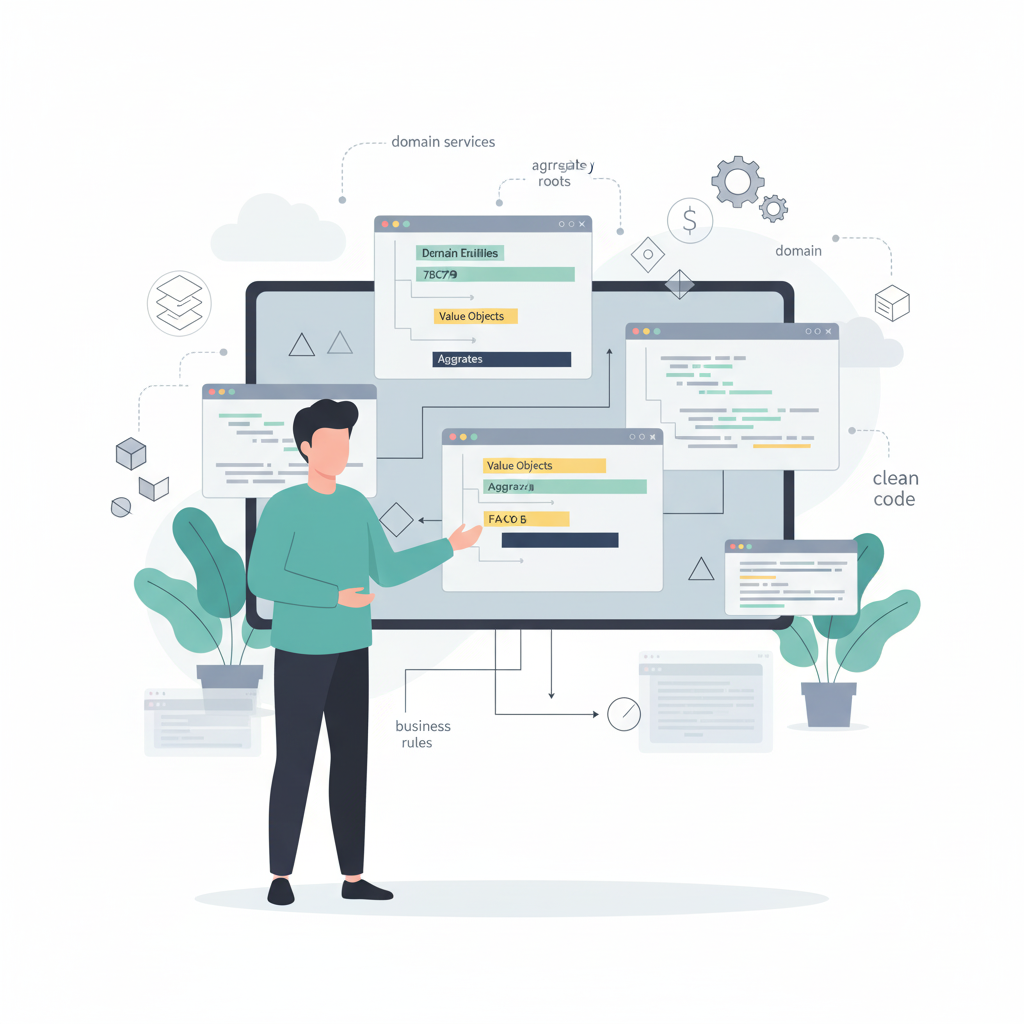Platform engineering has emerged as the key strategy for managing the complex challenge of scaling development teams from 20 to 500+ engineers. As teams grow, the cognitive load on developers increases exponentially—managing infrastructure, deployment pipelines, security configurations, and operational concerns while delivering business value. This guide is part of our comprehensive framework on how engineering teams transcend cognitive limitations through strategic platform thinking, exploring proven approaches to reduce developer cognitive burden through purposeful abstraction. Platform engineering addresses this challenge by creating Internal Developer Platforms (IDPs) that abstract infrastructure complexity behind self-service APIs and golden paths.
This strategic approach reduces cognitive load, accelerates delivery velocity, and maintains technical excellence while scaling. Rather than burdening developers with operational tasks, platform engineering creates dedicated teams that serve developers as customers, providing them with the tools and capabilities they need to focus purely on business logic. Understanding the science behind cognitive load in software engineering teams provides the theoretical foundation for why platform engineering delivers such powerful productivity improvements.
This guide provides a comprehensive implementation framework covering platform team formation, self-service capability design, golden path creation, and measurable success metrics. Learn when to implement platform engineering, how to build effective platform teams, and practical approaches to creating developer-friendly platforms that enable autonomous delivery teams while maintaining organisational standards and security requirements.
What is platform engineering and how does it differ from DevOps?
Platform engineering is the discipline of designing and building toolchains and workflows that enable self-service capabilities for software engineering organisations. Unlike DevOps which emphasises “you build it, you run it,” platform engineering creates dedicated platform teams that abstract infrastructure complexity, enabling application teams to focus purely on business logic while reducing cognitive load through standardised golden paths and automated workflows.
The fundamental difference lies in the division of responsibilities and customer focus. Traditional DevOps models often create inefficiencies where senior developers become burdened with operational tasks, reducing their ability to deliver business value. Platform engineering evolved from these DevOps challenges, particularly the complexity introduced by cloud-native architectures and microservices proliferation.
Platform teams treat developers as their customers, applying product management principles to create compelling internal products. This customer-centric approach ensures that platforms actually meet developer needs rather than imposing technology choices from above. The platform team focuses on providing “developer delight” while avoiding technical bloat and ensuring adoption across the organisation.
Microsoft predicts that 80% of engineering organisations will have platform engineering teams by 2026, reflecting the growing recognition of its value. The key distinction is that platform engineering provides “golden paths and paved roads” for developers, enabling self-service infrastructure and deployment capabilities while integrating various technologies into cohesive workflows.
When should a company implement platform engineering?
Companies should implement platform engineering when they have 20-100+ developers experiencing infrastructure complexity bottlenecks, deployment friction, and increasing cognitive load. Organisations with 20-30 developers should consider implementing an Internal Developer Platform to streamline workflows and reduce operational friction, though the optimal point typically occurs between 50-100 developers.
Key indicators include developers spending more than 30% of their time on infrastructure concerns rather than business logic development. This manifests as frequent deployment failures, environment provisioning delays exceeding 2-3 days, and teams duplicating infrastructure solutions across projects. Research shows that teams experiencing high cognitive load demonstrate a 76% correlation with burnout rates and a 68% correlation with turnover intention.
Business impact signals include slower feature delivery cycles, declining developer productivity metrics, and increasing operational scaling challenges. When new developers require weeks to set up environments or deploy changes, platform engineering provides immediate value through standardised processes.
Readiness assessment requires evaluating technical maturity, existing team structures, and leadership commitment. Organisations must have sufficient engineering capacity to staff a dedicated platform team and leadership willing to invest in developer experience improvements. The most successful implementations occur when organisations recognise platform engineering as a product investment rather than a cost centre.
How do you build and structure a platform engineering team?
Effective platform teams require 4-8 engineers with product management, infrastructure automation, and developer experience expertise. The team composition should include a platform product manager who treats developers as customers, DevOps/SRE engineers who understand infrastructure automation, developer experience engineers who focus on usability, and technical writers who create comprehensive documentation.
Team sizing follows the principle of serving 50-200 application developers per platform team member. Organisational placement requires independence and direct reporting to CTO or VP Engineering level leadership. Effective team organization for platform success ensures that platform teams integrate seamlessly with application development teams while maintaining clear boundaries and responsibilities. This approach aligns with the broader engineering effectiveness framework for managing cognitive limitations across engineering organizations.
Essential skills include infrastructure automation expertise, API design capabilities, and product thinking skills that help team members understand developer workflows and prioritise platform features based on user needs.
Cultural elements distinguish successful platform teams from traditional infrastructure groups. They maintain a product mindset, measuring success through developer adoption rates and satisfaction rather than uptime percentages. Platform teams must apply product strategy principles, using iterative development, frequent releases, and stakeholder feedback to ensure platform adoption.
The platform team structure should avoid becoming a bottleneck by focusing on self-service capabilities rather than request-response workflows. They provide tools, documentation, and automation that enable developers to accomplish their goals independently while maintaining escape hatches for complex edge cases.
What are golden paths and how do you implement them effectively?
Golden paths are opinionated, well-supported routes for common development tasks that represent the “blessed” way to build, deploy, and operate software with built-in best practices and guardrails. They provide templated compositions of well-integrated code and capabilities for rapid project development, reducing cognitive load through abstraction while maintaining development velocity.
Effective implementation begins with analysing high-frequency developer workflows to identify opportunities for automation and standardisation. Common golden paths include application scaffolding, deployment pipeline creation, environment provisioning, monitoring setup, and security scanning integration. Each path should provide a single, clear method to accomplish a task while covering the complete development-to-production journey.
Design principles emphasise developer experience first, ensuring that golden paths are significantly better than manual alternatives. They should be self-service, optional, and address organisation-specific needs. Progressive disclosure allows developers to start with simple defaults while accessing advanced configuration options when needed.
Implementation requires co-development between platform teams and stakeholder teams to ensure paths meet actual developer needs. Success measurement focuses on adoption rates, with targets of 90%+ developer usage indicating that paths provide genuine value.
Escape hatches remain essential for handling edge cases that don’t fit standard patterns. Golden paths should never become mandatory constraints that prevent teams from addressing legitimate technical requirements. Instead, they represent the recommended approach that works for 80-90% of use cases.
How does platform engineering reduce cognitive load for developers?
Platform engineering reduces cognitive load by abstracting infrastructure complexity behind simplified APIs and self-service interfaces, eliminating the need for developers to understand underlying systems. This approach specifically targets extraneous load from unnecessary complexity while preserving intrinsic load related to business problem-solving.
Infrastructure complexity creates significant cognitive load when developers must understand containerisation, orchestration, networking, security configurations, and deployment pipelines alongside business logic development. Platform abstraction hides these implementation details behind consistent APIs, allowing developers to focus their mental capacity on solving business problems.
Golden paths eliminate cognitive load by reducing decision-making overhead. Instead of researching deployment options, comparing CI/CD tools, or configuring monitoring solutions, developers follow established patterns that embody organisational best practices. This reduction in choice paralysis accelerates development velocity while ensuring consistency across projects. These patterns align with proven design patterns that platforms enable, creating multiple layers of cognitive load reduction throughout the development process. This systematic approach to cognitive load management is central to our strategic platform thinking guide for engineering excellence.
Research demonstrates that organisations successfully leveraging platform engineering report productivity improvements through reduced time-to-market, decreased operational overhead, and improved developer satisfaction. Teams experience fewer context switches between business logic development and infrastructure management.
Mental model simplification occurs when developers interact with consistent interfaces across environments and services. Rather than learning different deployment procedures for development, staging, and production environments, platform abstractions provide unified workflows that behave predictably.
What is an Internal Developer Platform and what should it include?
An Internal Developer Platform (IDP) is a curated collection of tools, services, and workflows that provides developers with self-service access to infrastructure capabilities without requiring deep operational knowledge. Evan Bottcher defines it as a foundation of self-service APIs, tools, services, knowledge and support which are arranged as a compelling internal product that enables autonomous delivery teams.
Core components include application scaffolding capabilities that help developers bootstrap new services with organisational standards built-in. Environment provisioning automation creates development, testing, and production environments on-demand without manual intervention. CI/CD pipeline integration provides automated testing, security scanning, and deployment capabilities through simple interfaces.
Secrets management integration ensures that applications can access credentials securely without exposing sensitive information in code repositories. Monitoring and logging capabilities provide observability into application behaviour across environments. Security scanning integration identifies vulnerabilities before deployment to production.
Developer portal integration, often implemented through platforms like Backstage, provides unified access to documentation, service catalogues, and platform capabilities. These portals serve as the primary interface between developers and platform services, offering self-service workflows while maintaining visibility into system dependencies.
The platform covers the complete application lifecycle, from initial development through production operations. Most successful implementations combine commercial tools with custom integration.
How do you measure platform engineering success and ROI?
Platform engineering success requires measuring developer experience metrics including lead time from code commit to production, deployment frequency, change failure rate, and recovery time from incidents. These DORA metrics indicate high-performing development teams and provide objective benchmarks for platform effectiveness. For comprehensive measurement approaches, see our guide on engineering effectiveness measurement frameworks and ROI assessment.
Developer productivity indicators complement DORA metrics with platform-specific measurements like time-to-first-deployment for new services, platform API adoption rates, and developer satisfaction scores. Lead time improvements often show the most dramatic gains, with successful platform implementations reducing deployment cycles from weeks to hours.
Platform-specific KPIs focus on self-service adoption rates, golden path usage percentages, and support ticket reduction. High-performing platforms achieve 80-90% adoption rates for golden paths, indicating that developers find platform capabilities genuinely helpful rather than burdensome.
Business impact measures translate technical improvements into financial outcomes. Feature delivery velocity improvements accelerate time-to-market for new capabilities. Operational cost reduction occurs through infrastructure standardisation and automation. Developer retention improvements reduce hiring and training costs.
ROI calculations compare platform investment costs against productivity gains. Most organisations see positive ROI within 12-18 months through improved developer productivity and reduced operational overhead.
How do you design self-service capabilities that developers actually use?
Successful self-service capabilities prioritise developer experience through intuitive APIs, comprehensive documentation, and automated workflows. Design starts with developer journey mapping to understand current workflows, identify friction points, and create capabilities that are significantly better than manual alternatives.
Implementation begins with analysing developer workflows to identify high-frequency tasks suitable for automation. Each capability should provide clear value propositions while maintaining flexibility.
UX considerations emphasise intuitive interfaces that follow familiar patterns. Error handling provides actionable feedback rather than cryptic technical messages. Progressive disclosure allows developers to start with simple defaults while accessing advanced configuration when needed.
API design follows REST principles with consistent resource naming and predictable response formats. Comprehensive documentation includes getting-started guides, API references, and troubleshooting information.
Adoption strategies focus on gradual migration rather than forced replacement. Champion programs identify early adopters who provide feedback and advocate for platform capabilities. Training sessions and office hours provide direct support during initial adoption.
Feedback mechanisms include usage analytics, error tracking, and regular developer surveys. Successful platforms iterate based on actual usage patterns rather than assumptions. Continuous improvement ensures that capabilities evolve with changing technology landscapes.
FAQ Section
What’s the difference between platform engineering and Site Reliability Engineering (SRE)?
Platform engineering focuses on building developer-facing platforms and tools that enable self-service capabilities, while SRE focuses on system reliability and operational excellence. Platform teams serve developers as customers through product-minded approaches, whereas SRE teams ensure production system reliability.
Should we build our own platform or use existing solutions like Backstage?
The decision depends on team size, technical complexity, and available resources. Teams under 100 developers often benefit from existing solutions like Backstage or commercial platforms, while larger organisations may need custom platforms. Most successful implementations combine open-source tools with custom integration layers.
How long does it take to implement platform engineering successfully?
Initial platform capabilities typically take 6-12 months to develop, with full organisational adoption requiring 12-24 months depending on team size and existing infrastructure complexity. Starting with lightweight implementations and iterating based on developer feedback accelerates adoption.
What are the most common platform engineering implementation mistakes?
Common mistakes include building platforms without user research, creating overly complex abstractions, insufficient documentation, lack of product management, and measuring success through infrastructure metrics rather than developer experience. Treating platforms as technology projects rather than product investments often leads to poor adoption.
How do you handle security and compliance in self-service platforms?
Security integrates into golden paths through automated scanning, policy enforcement, and guardrails that prevent common security mistakes while maintaining developer velocity. Secure-by-default configurations and automated compliance checking enable developers to deploy secure applications without deep security expertise.
What skills should we hire for when building a platform team?
Essential skills include infrastructure automation, API design, product management, developer experience design, technical writing, and strong communication skills. Cultural fit matters as much as technical skills—platform engineers must genuinely enjoy enabling other developers.
How do you prevent platform teams from becoming bottlenecks?
Platform teams avoid bottlenecks by focusing on self-service capabilities, providing comprehensive documentation, creating escape hatches for edge cases, and maintaining product mindset focused on developer enablement. They build tools and automation rather than processing requests.
What’s the relationship between platform engineering and DevOps?
Platform engineering evolved from DevOps to address cognitive load challenges at scale. While DevOps emphasises shared responsibility between development and operations, platform engineering creates specialised teams that enable other teams through self-service platforms while maintaining DevOps cultural principles.
How do you handle legacy systems in platform engineering implementations?
Legacy system integration uses strangler fig patterns, API gateways, and gradual migration strategies that allow modern platforms to coexist with legacy infrastructure while providing migration paths. Platform capabilities can abstract legacy systems behind modern interfaces.
What are the key success factors for platform engineering adoption?
Success factors include strong leadership support, product mindset, developer-centric design, comprehensive documentation, gradual migration strategies, and measurement of developer experience rather than just technical metrics. Treating developers as customers ensures platform capabilities meet actual needs.
Conclusion
Platform engineering represents a fundamental shift in how organisations approach infrastructure and developer productivity at scale. By creating dedicated teams focused on developer experience and self-service capabilities, companies can reduce cognitive load, accelerate delivery velocity, and maintain technical excellence while scaling their engineering organisations.
The key to successful implementation lies in treating platform engineering as a product discipline rather than a technology initiative. Platform teams must understand their developer customers, iterate based on feedback, and measure success through adoption rates and developer satisfaction.
Starting with lightweight implementations, focusing on high-impact golden paths, and building incrementally based on actual usage patterns ensures that platform investments deliver genuine value. For a complete overview of how platform engineering fits within the broader cognitive limitations strategy, explore our comprehensive guide covering the full spectrum of cognitive load reduction strategies. Organisations that embrace platform engineering today will be better positioned to compete in an increasingly software-driven economy while creating more satisfying work environments for their engineering teams.












